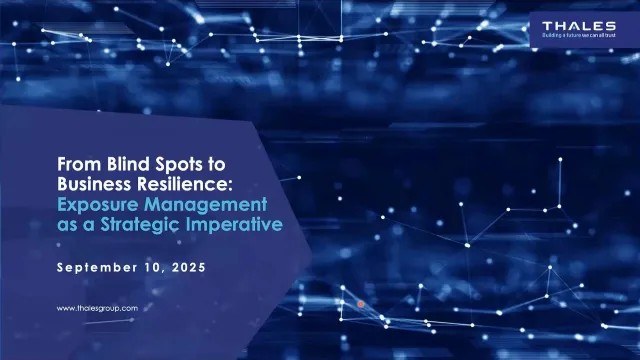Posted by
Share this article
Exposure management is now a strategic imperative for organisations facing complex digital threats. This article explains why traditional vulnerability management falls short and how Thales’s five-pillar framework: governance, risk, policies, operations, and audit, can help build business resilience and reduce your attack surface.
How to Build an Exposure Management Program
1. Establish clear governance and leadership ownership.
2. Contextualise exposures within your enterprise risk framework.
3. Document policies, procedures, and escalation pathways.
4. Coordinate operations across IT, OT, cloud, and development.
5. Implement continuous audit and assurance for feedback and improvement.
In the evolving world of cybersecurity, exposure management has emerged as one of the most critical priorities for organisations.
Traditional vulnerability management can no longer keep pace with today’s dynamic and complex digital environments. Therefore, Continuous Threat Exposure Management (CTEM) is required - a continuous, proactive approach to identifying, assessing, and addressing an organisation’s security risks across all digital assets and attack vectors.
This webinar, hosted by Thales Cyber Services experts Patrick Butler, Director - Emerging Technology and Ashur Williams, explores what exposure management means in practice, why it matters, and how organisations can adopt a pragmatic framework to reduce their attack surface before adversaries exploit vulnerabilities.
View Webinar:

Why exposure management now?
Vulnerability management has been around for decades, but the digital environment has evolved significantly, with unprecedented complexity. Organisations are juggling a diverse range of services and applications across cloud, on-premise IT, OT and IoT, and AI agents. Each adds a new layer to the attack surface.
At the same time, security teams are overwhelmed by the proliferation of tools, which results in gaps, overlaps, and uncertainty about priorities.
And the stakes are rising fast. Verizon’s 2024 Data Breach Investigations Report showed a 34% increase in vulnerability exploitation incidents year on year. Web application vulnerabilities in particular are a major contributor - yet many organisations with scanning tools still fail to leverage web app scanning capabilities.
Exposure management reframes the challenge - it’s not about a one-off assessment, but about continuous visibility, prioritisation, and remediation.
The Thales Cyber Services five-pillar framework
Drawing on its dual role as both a service provider and an operator of critical infrastructure, Thales has developed a five-pillar framework for exposure management. These pillars combine governance, risk, and operational execution to provide a comprehensive program.
Governance and leadership: Clear ownership, strategic alignment, and leadership buy-in are essential. Many programs fail not because of technology gaps, but because governance structures are weak.
Risk Management: Exposures must be contextualised within enterprise risk frameworks. Threat intelligence and compensating controls help prioritise remediation, especially in legacy environments where not every risk can be eliminated.
Policies and procedures: Documentation, escalation pathways, and remediation timeframes are the glue that keeps programs running. Staff churn and resource constraints often derail these processes but without them, even the best tools are ineffective.
Operations: Execution requires coordination across IT, OT, development pipelines, and cloud. Vulnerabilities rarely exist in isolation and low-level issues in one environment can cascade into critical exposures elsewhere. Cross-functional workflows are critical.
Audit and assurance: Continuous measurement matters. Internal monitoring of remediation performance and compliance is just as important as external audits. Without feedback loops, organisations lose visibility into whether exposure management is actually working.
From assessment to maturity
In the webinar, three common entry points for organisations beginning their exposure management journey were explored:
Exposure management assessment: A 12-24 month roadmap review across people, processes, and tools. What’s working and what needs to be fixed?
Deep dive assessments: Asset-class specific investigations, such as OT or identity, that combine technical tooling with workflow analysis. Uncover where you are exposed within your environment.
Uplift and remediation services: Moving beyond planning to execution, including automation of remediation processes that are impossible to scale manually
Implementing change now for the future
Exposure management is not a quick project - it’s a multi-year journey. However, if done correctly, the rewards are tangible, resulting in fewer breaches, reduced operational load, and stronger resilience.
The key to achieving this is continuous improvement, baking governance, processes, and visibility into day-to-day operations.
For organisations ready to take the next step, Thales is offering exposure management consultations because, in today’s cyber threat environment, reducing exposures before attackers exploit them is essential.
Contact us
Speak with a Thales Cyber Services ANZ
Security Specialist
Thales Cyber Services ANZ is a full-service cybersecurity and secure cloud services provider, partnering with clients from all industries and all levels of government. Let’s talk.




